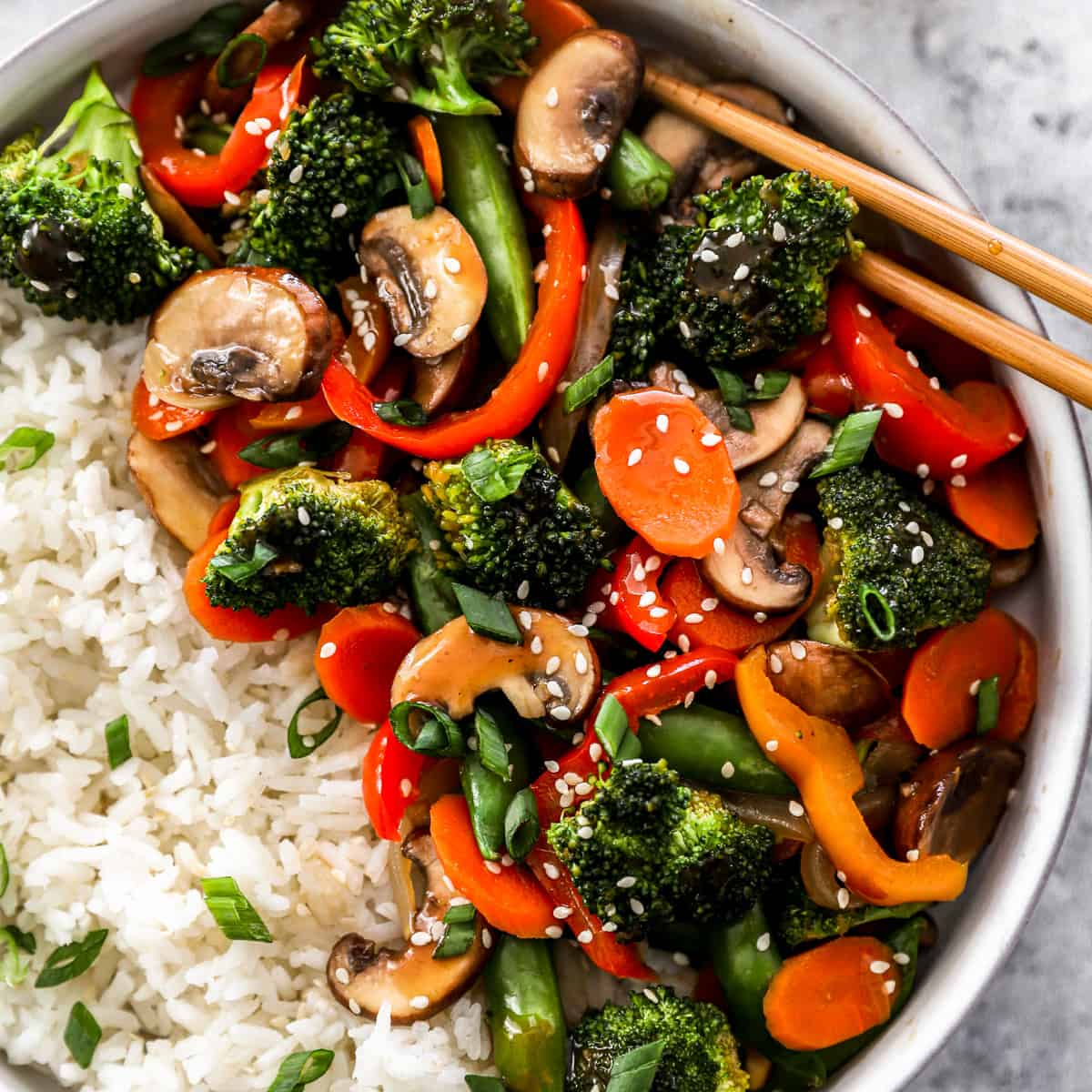Dive into a vibrant world of flavor and texture with our exploration of savory egg-free stir-fries brimming with colorful vegetables. Imagine the sizzle of perfectly seared tofu, the satisfying crunch of crisp-tender broccoli, and the aromatic dance of ginger and garlic – all without a single egg in sight! This culinary adventure unveils a universe of delicious and healthy possibilities, proving that egg-free cooking can be both exciting and incredibly satisfying.
We’ll guide you through crafting three unique stir-fries, each showcasing a different protein – tofu, chickpeas, and tempeh – alongside a carefully curated selection of vegetables. Discover the secrets to building balanced flavors and textures, mastering the art of sauce creation, and presenting your masterpieces in ways that are as visually stunning as they are delicious. Prepare to be inspired by the versatility of egg-free stir-fries, and ready to elevate your culinary skills to a new level.
Savory Egg-Free Stir-Fry Recipe Variations

Egg-free stir-fries offer a vibrant and versatile culinary landscape, perfect for those with egg allergies or those seeking to expand their cooking repertoire. The absence of eggs doesn’t diminish the flavor or texture; instead, it opens doors to creative substitutions and exciting flavor profiles. This section explores three distinct egg-free stir-fries, each showcasing a different protein source and a unique flavor profile.
Three Unique Savory Egg-Free Stir-Fry Recipes
The following recipes demonstrate the adaptability of stir-fries without compromising on taste or nutritional value. Each recipe highlights a different protein source, offering diverse textures and flavors.
Recipe 1: Tofu Delight Stir-Fry
Ingredients: 1 block extra-firm tofu, pressed and cubed; 1 red bell pepper, sliced; 1 green bell pepper, sliced; 1 cup broccoli florets; 1/2 cup snow peas; 1/4 cup soy sauce; 2 tablespoons rice vinegar; 1 tablespoon sesame oil; 1 teaspoon ginger, minced; 1 clove garlic, minced; 1/4 teaspoon red pepper flakes (optional).
Method: Heat sesame oil in a wok or large skillet over medium-high heat. Add tofu and cook until golden brown and slightly crispy, about 5-7 minutes. Add bell peppers, broccoli, and snow peas; stir-fry for 3-5 minutes until tender-crisp. In a small bowl, whisk together soy sauce, rice vinegar, ginger, garlic, and red pepper flakes. Pour sauce over vegetables and tofu; stir-fry for another minute until sauce thickens and coats everything evenly. Serve hot over rice or quinoa.
Recipe 2: Chickpea Curry Stir-Fry
Ingredients: 1 can (15 ounces) chickpeas, rinsed and drained; 1 onion, chopped; 2 cloves garlic, minced; 1 inch ginger, grated; 1 red chili pepper, finely chopped (optional); 1 cup cauliflower florets; 1 cup green beans, trimmed; 1/2 cup coconut milk; 2 tablespoons curry powder; 1 tablespoon lemon juice; 1 teaspoon ground cumin; Salt and pepper to taste.
Method: Heat oil in a wok or large skillet over medium heat. Add onion and cook until softened, about 3 minutes. Add garlic, ginger, and chili pepper (if using) and cook for another minute until fragrant. Stir in chickpeas, cauliflower, and green beans. Cook for 5-7 minutes, stirring occasionally, until vegetables are tender-crisp. In a small bowl, whisk together coconut milk, curry powder, lemon juice, cumin, salt, and pepper. Pour sauce over the vegetables and chickpeas; simmer for 2-3 minutes until sauce has thickened slightly. Serve hot with rice or naan bread.
Recipe 3: Tempeh Peanut Stir-Fry
Ingredients: 8 ounces tempeh, cubed; 1 cup sliced mushrooms; 1 cup shredded carrots; 1/2 cup chopped peanuts; 1/4 cup soy sauce; 2 tablespoons peanut butter; 1 tablespoon rice vinegar; 1 tablespoon honey or maple syrup; 1 teaspoon sesame oil; 1 clove garlic, minced.
Method: Heat sesame oil in a wok or large skillet over medium-high heat. Add tempeh and cook until browned and slightly crispy, about 5-7 minutes. Add mushrooms and carrots; stir-fry for 3-5 minutes until tender-crisp. In a small bowl, whisk together soy sauce, peanut butter, rice vinegar, honey/maple syrup, and garlic. Pour sauce over vegetables and tempeh; stir-fry for another minute until sauce thickens and coats everything evenly. Sprinkle with chopped peanuts before serving. Serve hot over brown rice or noodles.
Nutritional Comparison of Egg-Free Stir-Fry Recipes
This table highlights the nutritional differences between the three recipes, emphasizing the varied protein sources and vegetable combinations.
| Recipe Name | Protein Source | Key Vegetables | Sauce |
|---|---|---|---|
| Tofu Delight Stir-Fry | Tofu (high in protein, iron) | Bell peppers, broccoli, snow peas (rich in vitamins and antioxidants) | Soy sauce, rice vinegar, ginger, garlic (savory and umami) |
| Chickpea Curry Stir-Fry | Chickpeas (high in fiber, protein) | Cauliflower, green beans (rich in vitamins and fiber) | Coconut milk, curry powder, lemon juice (creamy and aromatic) |
| Tempeh Peanut Stir-Fry | Tempeh (high in protein, iron) | Mushrooms, carrots (rich in vitamins and minerals) | Soy sauce, peanut butter, rice vinegar, honey (savory and nutty) |
Texture and Flavor Analysis of Egg-Free Stir-Fries
The absence of eggs in these stir-fries results in unique textural and flavor profiles. The Tofu Delight offers a slightly firm yet tender tofu texture, contrasting beautifully with the crisp-tender vegetables. The savory soy-based sauce complements the mild tofu flavor. The Chickpea Curry boasts a hearty, slightly creamy texture from the chickpeas and coconut milk, while the curry powder lends a warm, aromatic depth. The Tempeh Peanut Stir-Fry presents a delightful combination of crispy tempeh and tender vegetables, all bound together by a rich, nutty peanut sauce. The absence of eggs doesn’t detract from the overall sensory experience; instead, it allows the inherent flavors and textures of the ingredients to shine through.
Optimal Vegetable Selection for Egg-Free Stir-Fries
Crafting a vibrant and flavorful egg-free stir-fry hinges on selecting the right vegetables. The key is to achieve a balance of textures and tastes, creating a symphony of culinary delights in every bite. Consider the interplay of crunchy, tender, sweet, and savory elements to elevate your stir-fry experience.
Vegetable Selection by Texture and Flavor Profile
A diverse range of vegetables contributes to a truly satisfying stir-fry. The following list showcases excellent choices, categorized for ease of planning and execution.
- Crunchy Vegetables: These add a delightful textural contrast. Examples include broccoli florets (bright green, firm, and slightly bitter), bell peppers (vivid red, yellow, or orange, with a sweet and slightly crisp bite), snow peas (tender, vibrant green pods with a delicate sweetness), and carrots (bright orange, firm, and subtly sweet). Consider the visual appeal of these vibrant colors when arranging your stir-fry.
- Tender Vegetables: These offer a softer counterpoint to the crunchy elements. Mushrooms (earthy, umami-rich, with varying textures depending on the variety), zucchini (pale green, mild-flavored, and easily softens), and spinach (deep green, slightly bitter, and wilts quickly) are excellent examples. Imagine the delicate contrast of the spinach’s gentle texture against the firmer broccoli.
- Sweet Vegetables: These add a touch of natural sweetness to balance any savory or bitter notes. Baby corn (tender, subtly sweet, and visually appealing), and sugar snap peas (bright green, slightly sweet, and crunchy) are excellent additions. The sweetness enhances the overall harmony of flavors.
- Savory/Umami Vegetables: These add depth and complexity to the stir-fry. Onions (pungent, sharp, and sweet depending on the variety) and garlic (potent, aromatic, and adds a savory base) are essential. Visualize the golden-brown caramelization of the onions as they soften during the stir-fry process.
Vegetable Preparation Techniques for Optimal Texture
Proper preparation is crucial for achieving the desired texture in each vegetable.
- Crunchy Vegetables: Broccoli should be cut into bite-sized florets to ensure even cooking. Bell peppers should be thinly sliced or diced to maintain their crispness. Snow peas and carrots should be sliced or halved depending on size. Imagine the satisfying crunch of perfectly cooked broccoli florets.
- Tender Vegetables: Mushrooms can be sliced or quartered depending on size. Zucchini should be sliced into half-moons or diced. Spinach should be washed thoroughly and added towards the end of the cooking process to prevent overcooking. Picture the tender, melt-in-your-mouth texture of the zucchini.
- Sweet Vegetables: Baby corn and sugar snap peas require minimal preparation, often just a quick rinse. Their delicate texture holds up well in the stir-fry.
- Savory/Umami Vegetables: Onions should be thinly sliced or diced to allow for proper caramelization. Garlic should be minced or finely chopped to release its full flavor. Visualize the fragrant aroma of garlic infusing the stir-fry.
Balancing Flavors and Textures in Egg-Free Stir-Fries
Achieving a harmonious balance of flavors and textures is key.
A successful stir-fry involves contrasting textures – crunchy with tender, and balancing flavors – sweet with savory, and perhaps a hint of bitterness.
Consider the following combinations: The sweetness of baby corn and carrots complements the earthiness of mushrooms and the slight bitterness of broccoli. The crunchy texture of bell peppers and snow peas contrasts beautifully with the softer texture of zucchini and spinach. The savory base provided by onions and garlic ties everything together, creating a balanced and satisfying dish. Visualize the vibrant array of colors and textures, each contributing to the overall culinary masterpiece.
From the satisfying sizzle of vegetables hitting the wok to the final flourish of a perfectly placed garnish, creating egg-free stir-fries is a journey of culinary exploration. This guide has equipped you with the knowledge and inspiration to craft vibrant, flavorful, and healthy meals that are as visually appealing as they are delicious. Experiment with different vegetable combinations, sauce profiles, and presentation styles to discover your own signature stir-fry creations. Embrace the freedom and flexibility of egg-free cooking, and savor the rewards of your culinary creativity.
Top FAQs
Can I use frozen vegetables in egg-free stir-fries?
Yes, frozen vegetables work well, but ensure they are thoroughly thawed and patted dry before adding them to the wok to prevent excess moisture.
How can I prevent my stir-fry from becoming soggy?
Use high heat, add vegetables in stages according to their cooking time, and don’t overcrowd the wok. Ensure your vegetables are properly dried before cooking.
What are some good substitutes for soy sauce in an egg-free stir-fry?
Coconut aminos, tamari (gluten-free if needed), or a combination of rice vinegar and maple syrup can offer similar umami flavors.
How long can I store leftover egg-free stir-fries?
Store leftovers in an airtight container in the refrigerator for up to 3-4 days.
Are egg-free stir-fries suitable for meal prepping?
Absolutely! They are perfect for meal prepping. Prepare the stir-fry components ahead of time and combine them just before serving to maintain optimal texture and flavor.


